Well I sort of liked Hungary. My first experience was when we had just picked up Peaches the campervan in the UK and drove back to Slovakia where we were living. It appealed to see some new countries so we went to Sopron (“Shop-ron”) for a bit. Hungarian pronunciation has and remains a bit of a mystery to me – much like Irish Gaelic. But anyway, we found ourselves in a pretty town on the southern edges of Lake Neusiedl/Lake Fertő near the Austrian border. The waiter was kind to our daughter in the café we ate in, but like any free-spirited two-year-old she was having none of it and ignored his efforts.
Who would have thought that in the end the Iron Curtain would be brought down not with a bang, but with basketfuls of sandwiches and hot dogs?
And yet that is what happened. On August 19, 1989 it was agreed to hold a “Pan-European Picnic” just outside Sopron, right on the border with Austria.
The idea was to open the border for about three hours and allow people to cross unchecked into Austria, taking a step further a process started two months earlier when Hungary and Austria, in the physical form of Gyula Horn and Alois Mock, had picked some notables to take some clippers and symbolically cut through the barbed wire.
The picnic organisers reckoned on a crowd of several thousand (it was over 10,000) who would come to enjoy the removal, albeit temporarily, of the once impregnable Iron Curtain. But they did not foresee about 600 canny East Germans who, hearing what was planned, thought they would take full advantage of the situation and escape to the West. The Hungarian border guards turned a blind eye and let the East Germans through. Although the border was subsequently resealed, a chain of events had been set in motion that led, less than three months later, to the fall of the Berlin Wall.
Today the site of those dramatic scenes is touted as an “international tourist attraction”. A lone watchtower – from which soldiers were at one time authorised to fire – is a reminder of how things once were.
Sopron – a delightful town dating back to Roman times that contains a wealth of medieval, baroque and rococo architecture “second only to that found in Budapest itself”. Sopron has another unique selling point: very Liechtensteinian in its quirkiness. The town has some 300 dentists and, while much of the trade comes from nearby (much more expensive) Austria, many of the practices now cater for English-speaking clients. There are worse places you could go to get your teeth seen to.
And then for us there were frequent trips from Bratislava for weekends in Budapest. Budapest is beautiful, and the locals will tell you that the most beautiful women in the world are from Hungary. On one trip, our daughter ran off down the train into a carriage where I met my now lifelong friend, Eric, a worryingly tall Californian who ran a language school in the capital. He was hospitable and invited us back to his flat. We were staying in a hotel on Andrassy – a wide main street where you could imagine the military parades of the communist era, so vividly depicted in the “Museum of Terror” , which showed in graphic detail the sufferings of the local population under first the Nazi, then the Russian occupations. Here there is a whole enormous wall of photograph portraits of the “disappeared” behind a real live Soviet tank, and rooms depicting the various offices of the various occupiers. Well-written leaflets in several languages tell the whole story. At the end of Andrassy lies Heroes Square, replete with soldiers in unfathomably clean boots and teenagers doing tricks on their mountain bikes, along with Roma beggars and passing tourists. Cross the bridge towards the Buda side of the two cities (Buda and Pest) and there is a funicular railway up to the lovely city on the hill. The taxi drivers from the station we found to be complete sharks and would drive you around for a good half hour for what should have been a five or ten minute ride.
My Dad, who was dying from cancer and walking with a stick, and my mum came to visit us in Bratislava. I knew it would not be long so wanted to show them the best of the region: time in Bratislava, trips to Vienna and Budapest but most of all time together. He was famous for accosting any random stranger and having their life story, family history and occupation of their father within a few short minutes. He did this a lot. Including on our trip to Budapest where I had found “bargain” accommodation behind one of those doorways that always make you wonder: “I wonder what it’s like behind there?” Well the answer was that the doorway was ornate and the building was a rambling old set of apartments that, judging by the ones we stayed in, were poverty-stricken ex-grand residences with electrical issues that freaked my wife out for the sake of our daughter. We ended up fashioning an outside table to eat at in the courtyard from the building debris that was left around and actually did quite a good job of this. It was interesting to wonder up the spiral staircase to explore the rest of the ancient building and Tash took some fabulous photos of puddles reflecting the impressive buildings all around. Up in a restaurant in Buda some very accomplished classical/folk musicians came and serenaded us and my Dad made friends on the street. The subway system was fabulous and the trains there were reminiscent of miniature Victorian toy trains. The escalators ran so fast, clanking in a surprisingly pleasing way, that we had to hold on to my Dad’s arm when getting on or off them.
On another occasion we stayed in a hotel with a roof top pool heated by thermal waters. How amazing it was to swim on this roof top, overlooking the snowy tiled roofs of Budapest on a freezing winter’s evening. Some Russian businessmen were there also. They led the way in their swimming habits, afterwards going to lie on the snow capped “sun loungers” on the roof top terrace and rubbing the good white stuff all over the corporately corpulent bodies. No matter; there was always the Christmas market a short distance below where the delicious punches could warm you to your very boot-tips.
Taking the train down from Bratislava we would pass the Danube Bend, where you could see the impressive basilica at Esztergom, just as the Slovak train crew were being replaced by Hungarians. You can see it from all around. Here it takes nine seconds for the reverberation echo to cease if you shout into its dome. Not that you would want to embarrass yourself in that way. One weekend we took off from Bratislava and camped here. The site had no electrical hook ups, but the accommodating owners ran a cable from their office to help us out and I got bitten by a snake as I put my hand into the wood pile to restock the campfire.
On the way down to Croatia we stopped once at Revfulop (I think the Hungarian pronunciation may well be something like “Burnham-on Sea”) on Lake Balaton. The campsite was a perfect lakeside location and the people there seemed rather more over-fed than the misnomer “Hungary” would suggest phonetically. Another favourite haunt was the thermal swimming pool in Gyor (“Gee-yer”) where the thermal spring fed the inside pool and you could swim out of the archway to the outside, perfectly warm in the water, even in the snow. You had to remember to take Forint down with you as they did not have Euros there. Eric called me a common tourist when I mistakenly referred to the currency as “Florint”, which made a lot more sense to me. And then we come to the way in which we saw the Hungarians dealt with the refugees when we were working on the Austro-Hungarian border down there. Neither country came out covered in glory from this, although I do know that some groups were doing some very philanthropic work down in Budapest with the multitude of migrants who found themselves camping out around Keleti Station in Budapest.
My Dad fell down into the street when we got back to Bratislava. He was lucky it was a weekend. He stumbled, tripping on the uneven surface and spiraled downwards in slow motion, grabbing at a roadside bollard on the way and then fell into the (weekday busy) street still in slow motion; he had cracked a rib on his camera as landed on the tarmac. It was one hell of a job to pick him back up and return him to the pavement. He was as stoic about the whole episode as he was about the dive we ended up in in Budapest when we went there together. And I think that if you are stoic then you will like Hungary. It has suffered a great deal from Russian and Nazi occupations. It treats minorities appallingly – Roma and more recently migrant refugees. But for me, somehow it charms and fascinates.

















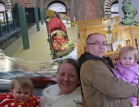








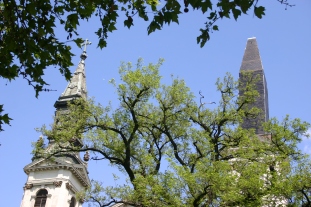




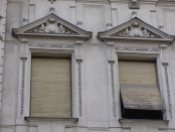














































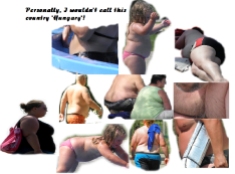





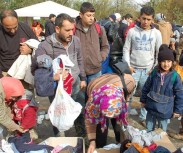

ONE THOUGHT ON “HUNGARY”
Beverley Caddington
OCTOBER 29, 2018 AT 5:42 PM EDIT
Lovely descriptions of Budapest. I stopped for an afternoon with a girlfriend. But the spas were not our attraction but the size of the ice cream sundaes!
Liked by you
REPLY
LikeLike
MARTIN BELLAMY More like this, Pete, please. It’s so good I almost don’t need to go.
PETE BAXTER You do need to go Martin. Absinthe (and Alison Bellamy) would love this interesting part of our – or rather sadly now THEIR – European history.
HELEN MOAT I really enjoyed both your stories and photographs, Pete. What a time – and for you to be there during that pivotal moment in German history. Also reminded me of my Danube/Istanbul cycle – which is always a good thing. Keep writing!
PETE BAXTER Thanks Helen Moat – comments from you are very respectfully received!
HELEN MOAT I should have said European history…
LikeLiked by 1 person